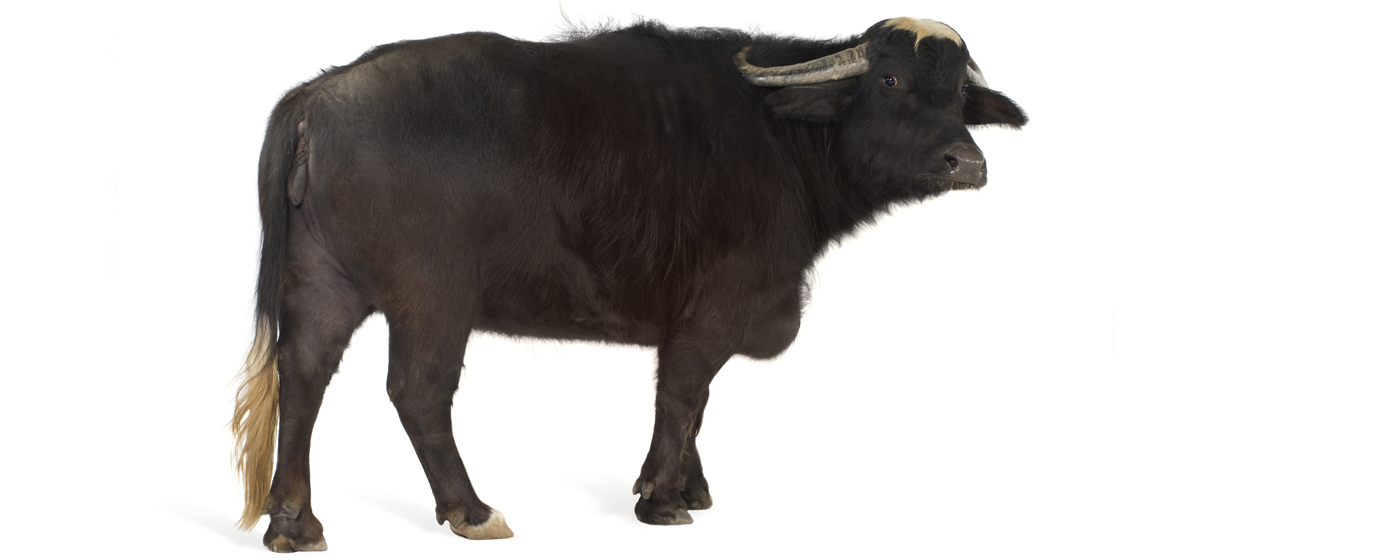Water buffalo
Originally from Asia, the water buffalo was domesticated in India and China over 7000 years ago. Nowadays it is bred on all continents, particularly for buffalo milk, which is more digestible and milder than cow’s milk, as well as being twice as rich. The high level of casein (a protein substance from milk) in buffalo milk facilitates the production of cheese, such as the famous mozzarella from Italy.
Asian origins, worldwide breeding
Originally from Asia, the water buffalo (Bubalus bubalis) was domesticated in India and China over 7000 years ago. Nowadays it is bred on all continents. There are two main species of water buffalo: the river buffalo and the swamp buffalo. The first accounts for 70% of the world’s water buffalo population and is mainly bred for its milk. The second is smaller, yields less milk and is, as such, mainly bred for animal traction and meat.
Buffalo milk accounts for 13% of worldwide dairy production (83% of dairy production is from cows, 2% from goats, 1% from ewes, 0.3% from camels and the rest from equines and yaks). Asia is home to 95% of worldwide buffalo milk production (FAO, 2015). India, Pakistan, China, Egypt and Nepal are the biggest producers. In fact, India and Pakistan produce more buffalo milk than cow’s milk.
A hardy animal
The water buffalo is a member of the Bovidae family and is characterised by its long, backward-curving horns and black colour. It is a powerful animal that can withstand extreme temperatures. It is mainly found in swampland and among tall marsh grasses. This herbivore consumes 2% of its weight in grasses, foliage and shoots every day (10 kg for an animal weighing 500 kg). It lives in a group of ten or so individuals. The herd mainly consists of females and their young, as the males usually keep their distance. The older females guide the group when travelling. Towards the end of a buffalo’s life, around twenty years old, the buffalo moves away from the herd to live alone. Usually calm, fearful and stubborn, it can nonetheless charge when threatened. The female buffalo can give birth every year. The gestation period lasts for ten months.
Nutrition
Buffalo milk is twice as rich in fat and proteins as cow’s milk. It is also more digestible and has a very mild flavour. Its high level of casein (a protein substance from milk) facilitates the production of cheese, such as the famous mozzarella from Italy.
Buffle. Larousse [en ligne]. [Consulté le 28 décembre 2015]. Disponible à l’adresse : http://www.larousse.fr
FAO/ONUAA | ORGANISATION DES NATIONS UNIES POUR L'ALIMENTATION ET L'AGRICULTURE, 2015. La production laitière et les produits laitiers. La composition de lait. FAO/ONUAA [en ligne]. 2015 [Consulté le 28 décembre 2015]. Disponible à l’adresse : http://www.fao.org
MEILI, Eric, 2011. Les buffles, une niche pleine d’avenir ? Bio Actualités. Plateforme des agriculteurs biologiques [en ligne]. 22 janvier 2011. [Consulté le 28 décembre 2015]. Disponible à l’adresse : http://www.bioactualites.ch
VERGONJEANNE, Robin, 2015. Reportage en Italie du Nord. Les bufflonnes font la fortune de l'élevage Moris. Terre-net Média [en ligne]. 14 août 2015. [Consulté le 28 décembre 2015]. Disponible à l’adresse : http://www.web-agri.fr




